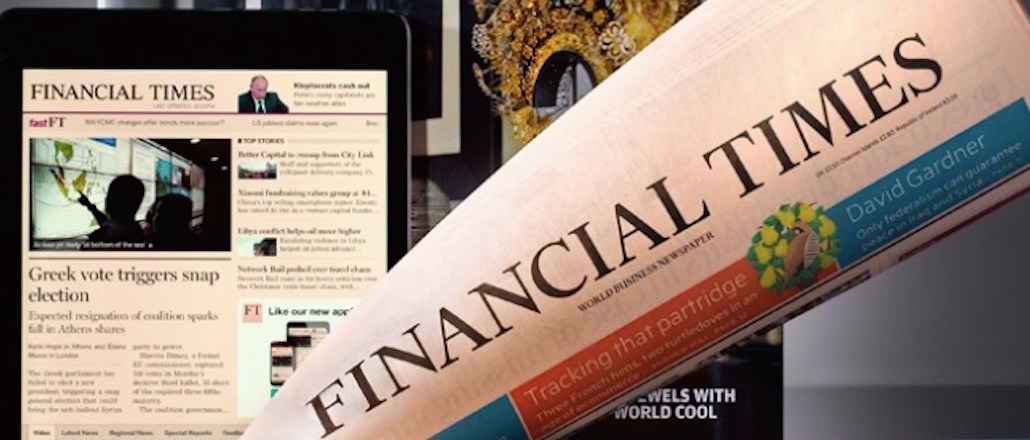Save 50% on a 3-month Digiday+ membership. Ends Dec 5.
How the Financial Times uses reader insight to evolve its native ad offering

Six months since its creation, the FT’s content marketing unit, FT Squared, is giving its paid posts a new look.
The FT’s branded content unit has been improving. Since the first paid post it ran in October, the publisher is seeing the time spent on these posts increase by 123 percent (although it wouldn’t disclose what the actual time was). And engagement is rivaling that on its editorial pieces.
FT Squared’s “Paid Post” format sits in a prime position on the FT homepage. Across the nine brand campaigns run through FT Squared since launch, it has improved click through rate from the home page by 30 percent, according to the publisher. Then they are taken to separate pages that contain client-voiced articles, videos and images, chosen by the brand.
“We’re now creating ambitious content environments that are immersive,” said Alexis Jarman, content activation director at the FT. Previously Paid Posts were similar in look and feel to FT articles, although labeled as paid. With the latest update these brand pages will be using the full width of the screen, on all devices, and include more multimedia features, like animated graphs and infinite scrolling. Here it borrowed from the success of its editorial special reports, particularly that of “Distinctive Living,” a series looking at expats around the world, adding in more multimedia features like the infinite scroll. “We saw significant increase in active engaged time,” said Jarman.
When FT Squared launched in September 2015 the aim was to offer more tailored advertiser partnerships around branded content, all under one banner. Increasingly, the publisher uses reader insight to inform content and adjust campaigns in real time. And it’s proving successful, in cases engagement paid for posts have matched that of editorial, according to Jarman.
“We’re learning about what the FT readers want and looking at the ways they interact with content,” she said. “Evolution is very much the right word. We’re far more reliant on the data to prove something, rather than going on intuition, and we can use that to be the consultant and advise clients.” This means it spends more time A/B testing on the home page the combination of the headline and the first line of the piece, the combination of text and images, whether posting a question or a statement. “As we run more campaigns, we will start to see more trends here, perhaps related to the sector of the client, or theme,” she said.
BP, a new client for the FT, is the first brand to make use of the new and improved Paid Posts, launching the campaign Committed to the U.K., currently only two articles have been published, “Changes in the World of Energy,” and “Why Scientists Give Science a Bad Name.” The next will publish in June, there’s currently no end date for the campaign, but in terms of tracking reader engagement, it is still in the exploratory phases.
Ad position: web_incontent_pos1

Previously FT Squared found even the smallest changes had positive impacts on a campaign’s performance. For instance, for an S&P Dow Jones campaign last month, the client’s campaign objective was to drive whitepaper downloads. Such a small step as hyperlinking to the downloadable report — rather than featuring a large download button at the end — at resulted in 15 percent of those reading the article go on to download the whitepaper.
For a technology client, NTT Communications, last month the brand first ran a piece with FT Squared around a broad subject matter. Here it found that active engaged time (identified by mouse movements) and scroll depth were performing well. In the second piece the focus was more relevant to the brand, and the click through rate to the brand’s site was higher. “If delivering insight and awareness is the objective then a more broad subject matter works, or if click through rate is important then the piece can be more authentic to the brand,” said Jarman.
Of course, native solutions take time and resources. Currently the FT Squared team itself stands at five people and it’s “efficient,” but it pulls on the expertise of the commercial and data teams for audience insight, and external editorial contributors. Jarman said there are plans to staff up.
FT Squared solutions are outside the FT’s paywall, and the publisher helps advise on distribution through its own platforms, the brand’s sites and on Twitter in order the reach the right audiences. As such, the FT’s rate card is as bespoke as its solutions. As FT Squared grows it will continue to offer more fluid packages around specific customer journeys, and increase targeting around the FT’s audience.
Ad position: web_incontent_pos2
“It’s important to think of native advertising in context,” said Jarman, “it means a lot of different things to different people.”
More in Media

Digiday+ Research Subscription Index 2025: Subscription strategies from Bloomberg, The New York Times, Vox and others
Digiday’s third annual Subscription Index examines and measures publishers’ subscription strategies to identify common approaches and key tactics among Bloomberg, The New York Times, Vox and others.

From lawsuits to lobbying: How publishers are fighting AI
We may be closing out 2025, but publishers aren’t retreating from the battle of AI search — some are escalating it, and they expect the fight to stretch deep into 2026.

Media Briefing: Publishers turn to vertical video to compete with creators and grow ad revenue in 2026
Publishers add vertical video feeds to their sites to boost engagement, attract video ad spend and compete with news creators.
Ad position: web_bfu


